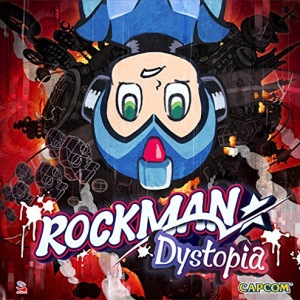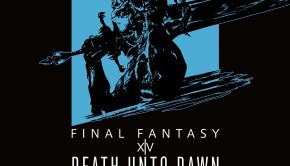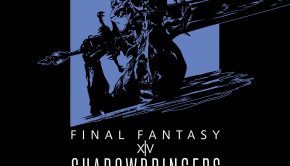Mega Man Dystopia
 |
Album Title: Mega Man Dystopia |
| Record Label: Suleputer |
|
| Catalog No.: CPCA-10377 |
|
| Release Date: February 11, 2015 |
|
| Purchase: Buy from CDJapan |
Overview
In contrast to the more lighthearted tones of Rockman Utopia, its complementary album, Rockman Dystopia, focuses more on heavy rock and electronic remixes. Featuring veteran Basiscape members Yoshimi Kudo, Azusa Chiba, Masaharu Iwata, Mitsuhiro Kaneda, Masaaki Kaneko, and its newest composer, Kazuki Higashihara, as well as Yasumasa Kitagawa, of Capcom, how does this effort turn out?
Body
The album opens with a medley dedicated to the character, Zero, from the Megaman X series called “The Last No. Zero (Zero Theme Medley),” arranged by Yoshimi Kudo. The medley itself consists of the “X vs. Zero” theme from Megaman X5, as well as his character themes from the first three games in the series, as well as “zero’s sacrifice” from the PSP remake of Megaman X. Given that rock is Kudo’s forte, the tune is a synth/heavy rock hybrid and features some great solo sections, although it also provides some softer sections that contrast quite nicely with the high-octane nature of the arrangement. It’s a great opening tune for the album. Kudo’s other contribution is “Justice of Dys World (Climax Battle Medley),” a medley of final boss themes from Megaman X4, X7, and X8, related both to Sigma and Lumine. There is a heavier sound in this piece compared to the opening tune, with plenty of heavy rock riffs, some neat guitar work, electronic distortion, and even some orchestral tones as well. Of his two arrangements, this one is my favorite, although I wish he did a dedicated arrangement to a singular piece from the Megaman X universe rather than two medleys like the other arrangers who handled two pieces on the album, as you’ll see below.
Azusa Chiba also contributes two arrangements to the album. The first, “Beware of No Man More Than Thyself (Boomer Kuwanger Stage),” from Megaman X1, is a hard-hitting tune with some wonderful contrast. I love how there are areas with heavy wobble effects and lots of electronic distortion, to give it a gritty sound, as well as some more upbeat and softer synth led dance-like sections that would fit well within a Cave shooter. In both cases, the original melody is given a chance to shine and complements both types of soundscapes quite nicely. Her other tune, “You’d Better Be Nippy (Ice Stage Medley),” is a very unique take on the themes dedicated to Ice Penguin, Crystal Snail, and Blizzard Wolfang, from X, X2, and X6, respectively. This theme is quite abstract, reminiscent of Mitsuhiro Kaneda’s Deathsmiles arrangement with its crystalline sound, although this one is much darker, featuring some really dark tones, distorted electronic tones, wispy vocals that bring a mysterious tone to the piece, and a very dissonant and chaotic sound. It really captures the idea of a dystopian atmosphere quite nicely.
Basiscape’s newest member, Kazuki Higashihara, also contributes two tracks, a medley as well as a singular arrangement. The medley, “Flame Gate (Flame Stage Medley), features the music from Megaman X2, X3, and X6 and tackles the themes for Flame Stag, Blast Hornet, and Blaze Heatnix, respectively. His arrangement is rock focused and features some heavy sounds, particularly in the medley. As for the medley it progresses quite nicely and features some excellent guitar work. The use of electronic tones is minimal in this arrangement compared to some of the others and are typically utilized in the last portion of the medley, which takes on a more synth-rock approach. His other arrangement, “Dim Ciras (VS 8Boss),” from Megaman X8, is another heavy rock oriented arrangement. Of his two arrangements, this one is the clear winner. His interpretation of the track brings a lot of energy to the mix and the guitar work is extremely powerful. As with his other arrangement, electronic elements aren’t the focus, used as accompaniment, although there are some synth rock sections as well as some softer piano led sections where the electronic elements, typically distortion, help bring a softer side to the track.
The rest of the contributions on the album are singular arrangements from the remaining composers. Masaaki Kaneko, Basiscape’s sound effects member, gets his own arrangement, “46414C4C (Cyber Peacock Stage), from Megaman X4. His arrangement is largely drum n’ bass influenced that brings a nice energy to the original, although that’s certainly not the only influence that helps craft the arrangement. In addition, there are some dubstep-like sections that work well with the softer interpretations of the melody. It’s one of the surprises on the album and makes me wish that Kaneko was able to have a larger compositional role at Basiscape. Capcom’s Yasumasa Kitagawa takes on Megaman X with his arrangement, “Vertical Resonance (Armored Armadillo Stage).” His arrangement has a nice EDM style interpretation and is certainly one of the most danceable tunes on the album. The melody itself remains pretty much intact and the arrangement itself is, for the most part, straightforward, although there are some sections that help spice things up a bit. In the end, it’s an enjoyable arrangement and a nice midpoint on the album.
The last two contributors to the album, Masaharu Iwata and Mitsuhiro Kaneda, deviate from the overall sound of the album and in one case, I find the arrangement to still fit with the overall scope of the album, while the other certainly falls flat in that regard. Iwata’s arrangement, “Rust Orbit to Dusk (Gravity Beetle Stage),” from Megaman X3, is the arrangement that I find to be successful in fitting with the dystopian atmosphere of the Megaman X series. Despite having a softer tone than most of the album, the atmosphere the track exudes makes me think of sci-fi post apocalypse. The cinematic approach works very well and once you get over the initial shock of how downtempo this version is compared to the original, there is a lot to appreciate. In addition, the industrial tones featured in the accompaniment help to reinforce the post apocalyptic atmopshere. It is a truly unique interpretation, although it might not be for everyone. Lastly, Kaneda’s “Espero faras nenion (Esperanto),” from Megaman Zero 4, is the album’s weakest track. It doesn’t have nearly the same vibe as any of the other tunes and it doesn’t adhere to the Megaman X series, rather going to the series that chronologically takes place after it. There are some light industrial tones that certainly do attempt to fit within the confines of the atmosphere of the album, but the soft piano led melody, although as the album progresses, there is a grittier guitar focus, is much more appropriate for the Rockman Utopia album, if you were to take away the electronic distortion, etc. That being said, that track itself is certainly enjoyable, but certainly a missed opportunity compared to how the other arrangements on the album were handled.
Summary
The Rockman Dystopia album is an extremely successful arrange album dedicated largely to the Megaman X series, an oft ignored series when it comes to such albums. The styles, featuring a blend of rock and heavy electronic arrangements, fits well within the atmosphere of both the series and the idea of a dystopian society. Another thing this album does well, compared to its counterpart, is the fact that all the games in the Megaman X universe are represented and there is less focus on medley and more focus on individual track arrangements, which I think allows the arrangements to be more creative in the long run. Fans of the series’ music and those who like rock/electronic remixes will certainly enjoy most of the offerings on this album.
Do you agree with the review and score? Let us know in the comments below!
4.5
Posted on March 25, 2015 by Don Kotowski. Last modified on January 19, 2016.














